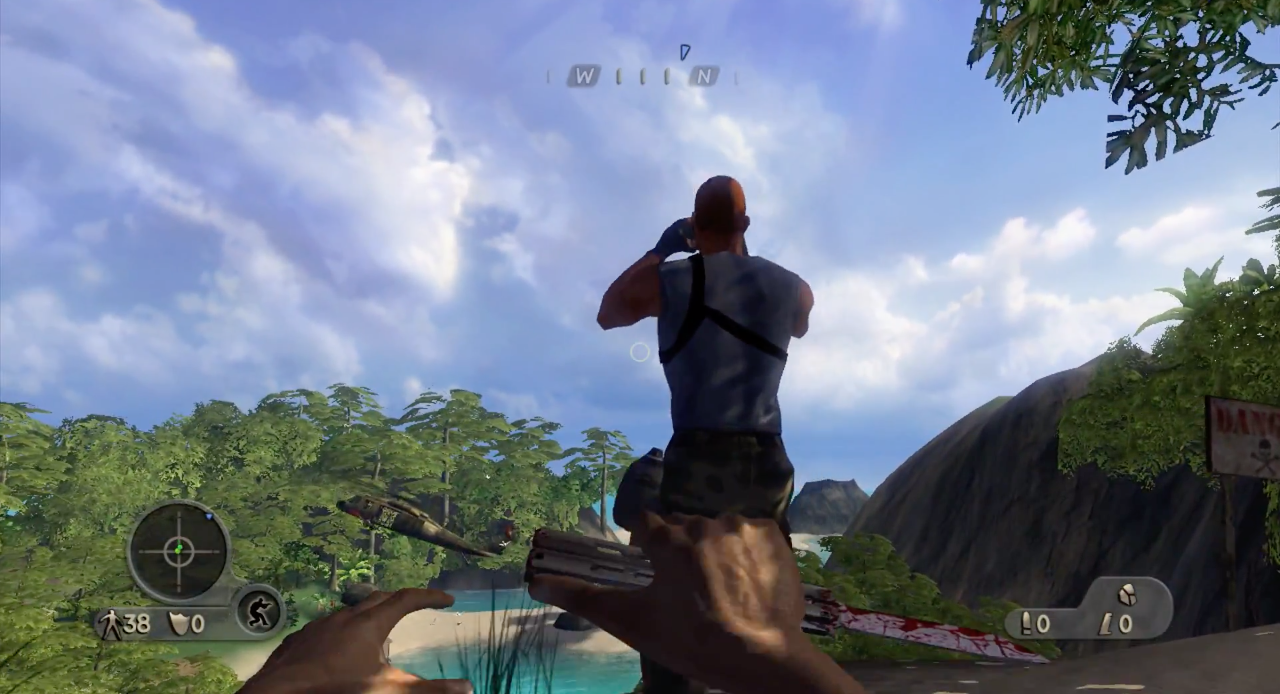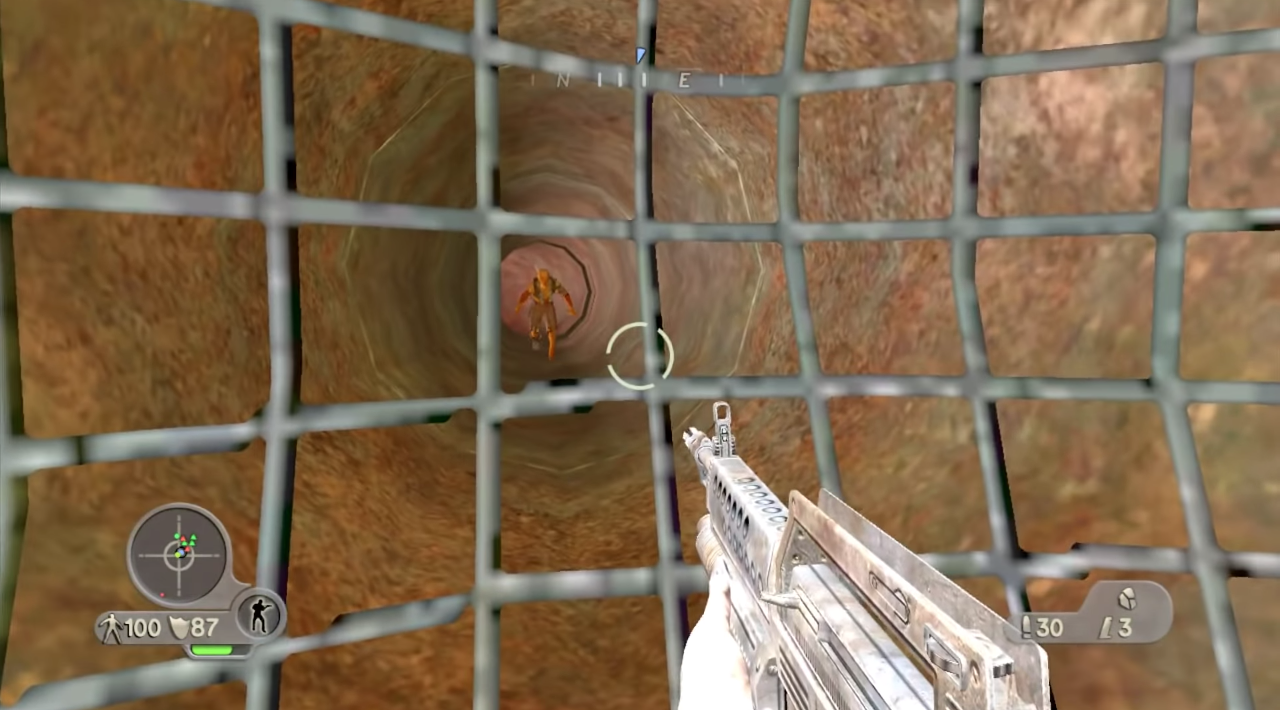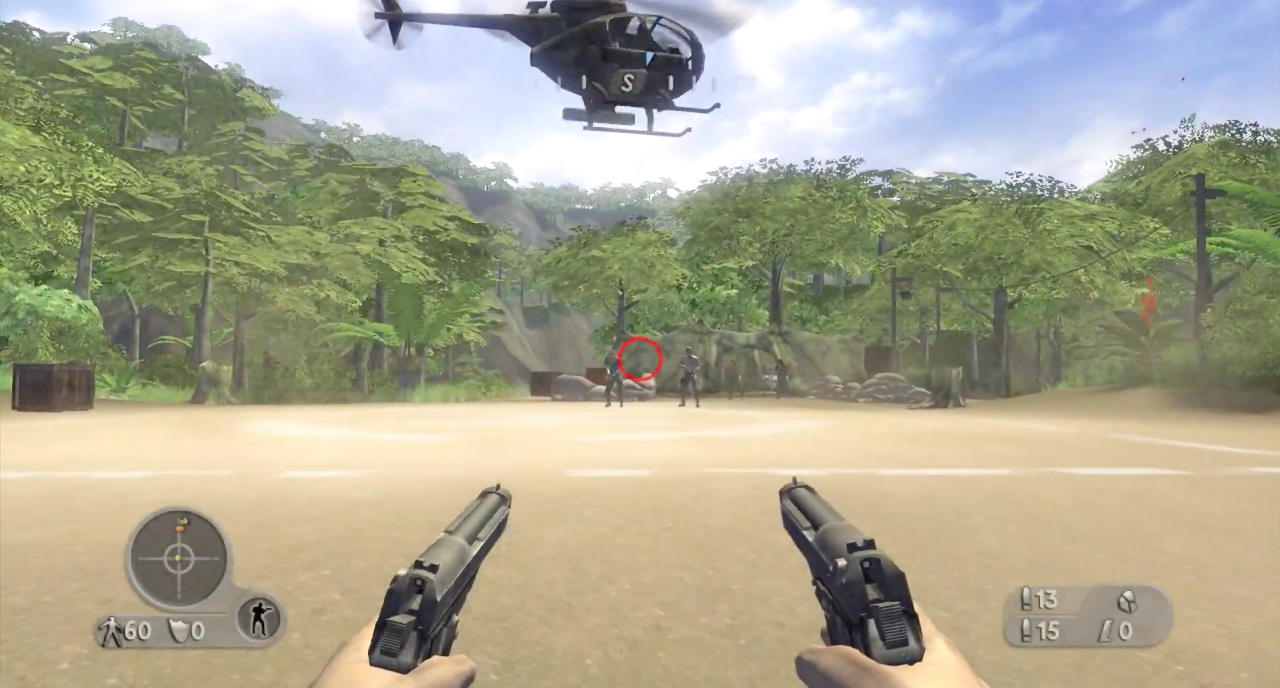

“You’re Jack Carver, captain of a pile of floating debris and burning fuel that used to be the Lady Karma. Now you have one shot at survival.”
The first thing I noticed when booting up Far Cry Instincts was that, before you even pick up a gun or see your first enemy, you brandish a butterfly knife that is already dripping blood. A funny oversight1 but one that points toward the blood-soaked adventure ahead of you. A console remake of Far Cry (a game which I really should play again), the game is unashamed of its B movie aesthetic. With a cheesy, trope-filled narrative that’s barely worth following and a veritable swarm of enemy AI dogging your every move, the game is about as run and gun as you can get. It offers immediate, visceral fun and really pushes the Xbox console to its limits. Upon release in 2005, it was seen as an inferior but still solid remake; fifteen years later, it still plays pretty well, but some frustrating design choices and unfulfilled ambitions mar the enjoyment to a certain degree.
Far Cry was originally a PC game developed by Crytek, an obscure German developer who had their own in-house engine dubbed the CryEngine. Released in early 2004, Far Cry beat other developers’ big name FPS games to market—for context, highly anticipated sequels like Doom 3, Halo 2, and Half-Life 2 were all scheduled to release later that year—and their time-conscious release was richly rewarded to the tune of 2.5+ million sales. Crytek parted ways with the franchise (moving onto develop Crysis) and handed it off to Ubisoft, who had published the first game. To capitalize on the growing console FPS market, Ubisoft decided to port the game, a task that forced them to fundamentally change it but which also led to some fun enhancements. Due to the limited processing power of the Xbox (GameCube and PS2 versions were scrapped), Ubisoft had to corral the expansive open world maps into more linear versions. However, they also supplemented the combat with “feral abilities,” which you begin to develop after you receive some kind of injection. Basically it’s like you get to play as Wolverine in first-person except you also have machine guns. Like I said, it’s like a B movie—a really gore one.

That plot device—the “mad scientist” trope brought to life in the form of Dr. Krieger, who sticks the needle into your arm—is typical of the game. The principal characters are all of that generic stock—illegal arms dealers, lone wolf CIA agents, rogue computer hackers, genociders. The abilities are only given to you gradually. First, your health replenishes on its own (as opposed to the pickups which previously functioned as your only source of health). By the end of the game you’ll be running fast, jumping high and long, seeing in the dark, and following the heat scents of your enemies.
While the addition of feral abilities is fun, I found that their inclusion almost completely obscured the stealth mechanics available to the player. In the game’s introductory level, you’re shown how to backstab and rig whip traps for your enemies, and how to throw small rocks to lure them into place. You can also plant C4 and go prone on your back to shoot up through floorboards. These elements seem very cool in theory and occasionally work well, but I thought they were improperly balanced. The enemy AI is very alert and their detection system is hard to get a handle on, so after a handful of failed attempts at sneaking around an area using stealth, you become incentivized to just blast/claw your way through.
I believe that the game utilizes both pre-placed enemies and others that spawn when you hit a certain threshold. The former are cool because, if you do your sneaking well, you can overhear snippets of conversation or witness them moseying about their routes rather than standing stock still awaiting your arrival. They make the game feel almost, though not quite, like it’s a living and breathing thing. The latter are annoying because they’re usually placed in disadvantageous locations meant to funnel you into a high risk firefight. They often spawn behind you while you’re on the move, which really makes a systematic combat style feel pointless at times because you know the encounter will inevitably devolve into chaotic rampaging. Otherwise, the AI is mostly the run-of-the-mill, borderline incompetent crony-types that were pretty standard for the era. They soak up bullets without flinching and run out into the open to give you clean shots.

As a shooter, Instincts is fairly good. Unremarkable controls that don’t feel especially smooth but are certainly serviceable. But it is most invigorating when you are able to string together a nice run where the speedy movement and endless gunning work in tandem. The sheer range of attack options, if utilized in their entirety, really give Instincts a fun sense of predatory hunting. It’s like the reverse of a horror game where you peer into the murky darkness and assess the threat. In Instincts, once you’ve unlocked your full arsenal of animalistic attributes, you are the threat lurking in the shadows, stalking the scent of your prey and opportunistically taking them out.
Although the levels are fairly linear, they are still extremely large, and there are no loading screens until you reach a level’s conclusion. To navigate, the player is provided with a number of vehicles—jeeps, ATVs, gunboats, hoverboats, hang gliders… they control as roughly as you’d expect for a game primarily focused on shooting, but their inclusion is welcome in any case. While the simple Rambo charge sufficed to plow through the lower difficulties, Predator difficulty requires a bit more tact. The stealth mechanics are certainly the most rewarding method for taking on the hordes of enemies, but not the most expedient, and so the strategy I employed most often was a measured form of run and gun. The checkpoints are pretty frequent, so taking a stab at speed-jumping through a section is always a legitimate option; though the tougher sections will reward such an attempt with a sniper bullet to the face and and a reload screen.

There are multiplayer modes that were fairly popular once Xbox Live took off and the game was re-released (along with its sequel, Evolution) as Far Cry Instincts: Predator on the Xbox 360. It also added a map editor that I remember messing around with quite a bit on my own, though I didn’t have Live at the time and my friends were more inclined to play other things. Unfortunately, any chance of me sinking some time into the multiplayer is long gone, as gamers have long forgotten it and I have a limited appetite for online gaming.
Ultimately, Far Cry Instincts has enough elements that appeal on their own—large maps, feral abilities, stealth mechanics, cool setting, vehicle variety—that it overcomes the lack of cohesion amongst those elements. Forced to linearize the expansive PC game, Ubisoft largely follows general FPS convention, but it’s among the better games of that type and era.
1. I actually think it’s cool that Ubisoft made the weapon look this way, and wouldn’t expect them to have changed it for the small opening section of the game. The fix would have been to show a cutscene of Jack Carver knifing someone prior to allowing you to equip the knife. Anyway, I just thought it was funny.